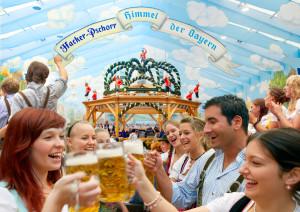 In Bavaria, a state of Germany located in the country’s southern region, September brings about the most beloved of all ‘fests; Oktoberfest. The festival has a two-hundred-year history that has seen it grow from a local celebration to the world’s largest fair that lasts 16 days and hosts nearly six million people from around the world.
In Bavaria, a state of Germany located in the country’s southern region, September brings about the most beloved of all ‘fests; Oktoberfest. The festival has a two-hundred-year history that has seen it grow from a local celebration to the world’s largest fair that lasts 16 days and hosts nearly six million people from around the world.
To give you an idea of the scope of Oktoberfest, let’s take a look at the astounding numbers generated by the event each year. Last year the event was attended by 5.9 million people, who consumed approximately 7.7 million liters of beer, ate more than 500,000 roasted chickens and 330,000 sausages. The festival grounds cover 42 acres – approximately the size of 32 Everbank Fields – and contained 14 massive beer tents with room for up to 10,000 partiers.
To the locals Oktoberfest is known as “die Wies’n,” after the informal name of the fairgrounds. Oktoberfest is an important part of Bavarian culture, having been held since 1810. Other cities across the world also hold Oktoberfest celebrations including several here in Jacksonville.
The beginnings of Oktoberfest harken back to 1810 when Crown Prince Ludwig, who later became King Ludwig I, married Princess Therese of Saxe-Hildburghausen on October 12. The happy couple wanted to share their joyous occasion with the citizens of their beloved Munich, so they invited all to attend the festivities held on the fields in front of the city gates. The fields were named Theresienwiese (“Theresa’s meadow”) in honor of the Crown Princess, and have kept that name ever since, although the locals have since abbreviated the name simply to the “Wies’n”. Nearly 40,000 Bavarians crowded the fields and enjoyed the fanfare and revelry.
The event ended with horse races attended by the Royal Family. The decision to repeat the horse races the following year gave rise to the tradition of the Oktoberfest. In 1816, carnival booths began appearing at the event with prizes consisting of silver, porcelain, and jewelry. The founding citizens of Munich assumed responsibility for festival management in 1819 and it was decided to make the Oktoberfest an annual event.
Only beer conforming to the Reinheitsgebot – sometimes called the German Purity Law — at a minimum of 13.5% Stammwürze (approximately 6% alcohol by volume) may be served at Oktoberfest. To tie the festival to its home town, only beers brewed within the city limits of Munich may be served within the gates. Only beers meeting these criteria may be designated Oktoberfest beer. Other similar beers, brewed outside of Munich, are more correctly called Oktoberfest-style.
There are only six breweries that meet all the above criteria. These breweries include: Augustiner-Bräu, Hacker-Pschorr-Bräu, Löwenbräu, Paulaner-Bräu, Spatenbräu, Staatliches Hofbräu-München.
In 1950 the festival adopted a ceremonial opening presided over by the incumbent mayor of Munich. In the new tradition, at high noon on the first day of the festival there is a 12-gun salute followed immediately by the mayor tapping and drawing the first beer of the festival. When the first stein is filled, the mayor faces the crowd and shouts, “O’zapft is!” which translates to, “It is tapped!” The mayor then presents the first mug to Minister-President of the State of Bavaria. After the ceremony the beer begins to flow and the party truly fires up.
Advertisements